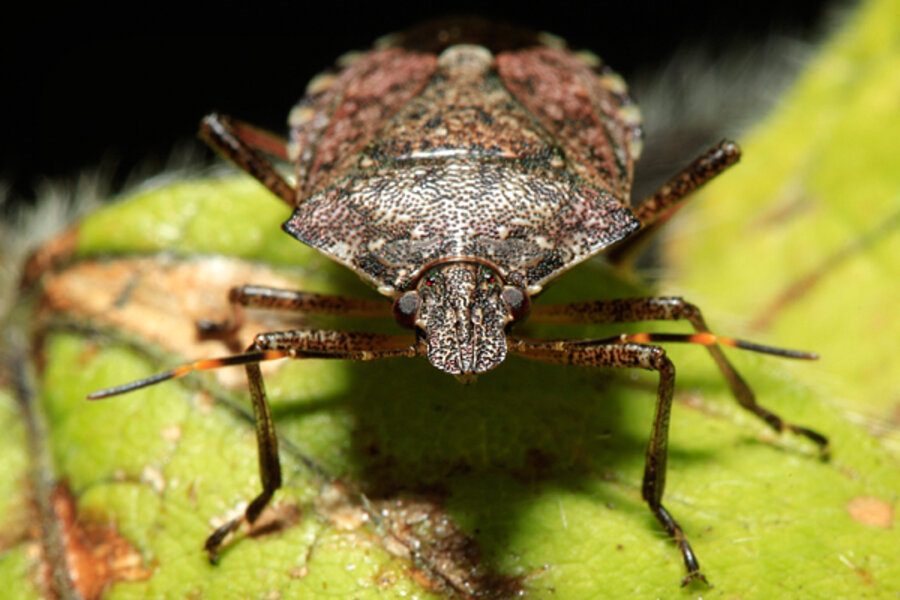Stink bugs, termites could soon be part of your diet
As the human population continues to inch closer to 8 billion people, feeding all those hungry mouths will become increasingly difficult. A growing number of experts claim that people will soon have no choice but to consume insects.
As if to underscore that claim, a group of students from McGill University in Montreal has won the 2013 Hult Prize, for producing a protein-rich flour made from insects. The prize gives the students $1 million in seed money to begin creating what they call Power Flour. "We will be starting with grasshoppers," team captain Mohammed Ashour told ABC News on Monday (Sept. 30).
Earlier this year, the Food and Agriculture Organization of the United Nations (FAO) released a report titled, "Edible Insects: Future Prospects for Food and Feed Security." The document details the health and environmental benefits derived from a diet supplemented by insects, a diet also known as "entomophagy." Gleaned from the FAO document and other sources, here's a list of seven edible insects you may soon find on your dinner plate.
Mopane caterpillars
Mopane caterpillars — the larval stage of the emperor moth (Imbrasia belina) — are common throughout the southern part of Africa. Harvesting of mopane caterpillars is a multi-million dollar industry in the region, where women and children generally do the work of gathering the plump, little insects.
The caterpillars are traditionally boiled in salted water, then sun-dried; the dried form can last for several months without refrigeration, making them an important source of nutrition in lean times. And few bugs are more nutritious: Whereas the iron content of beef is 6 mg per 100 grams of dry weight, mopane caterpillars pack a whopping 31 mg of iron per 100 grams. They're also a good source of potassium, sodium, calcium, phosphorous, magnesium, zinc, manganese and copper, according to the FAO.
Chapulines
Chapulines are grasshoppers of the genus Sphenarium, and are widely eaten throughout southern Mexico. They're often served roasted (giving them a satisfying crunch) and flavored with garlic, lime juice and salt, or with guacamole or dried chili powder. The grasshoppers are known as rich sources of protein; some claim that the insects are more than 70 percent protein.
Researchers have noted that the gathering of Sphenarium grasshoppers is an attractive alternative to spraying pesticides in fields of alfalfa and other crops. Not only does this eliminate the environmental hazards associated with pesticide sprays, it also gives the local people an extra source of nutrition and income, from the sale of grasshoppers. [Gallery: Dazzling Photos of Dew-Covered Insects]
Witchetty grub
Among the aboriginal people of Australia, the witchetty grub is a dietary staple. When eaten raw, the grubs taste like almonds; when cooked lightly in hot coals, the skin develops the crisp, flavorful texture of roast chicken. And the witchetty grub is chock full of oleic acid, a healthful omega-9 monounsaturated fat.
Though people often refer to the larvae of several different moths as witchetty grubs, some sources specify the larval stage of the cossid moth (Endoxyla leucomochla) as the true witchetty grub. The grubs are harvested from underground, where they feed upon the roots of Australian trees such as eucalyptus and black wattle trees.
Termites
Want to get rid of the termites gnawing at your floorboards? Just do like they do in South America and Africa: Take advantage of the rich nutritional quality of these insects by frying, sun-drying, smoking or steaming termites in banana leaves.
Termites generally consist of up to 38 percent protein, and one particular Venezuelan species, Syntermes aculeosus, is 64 percent protein. Termites are also rich in iron, calcium, essential fatty acids and amino acids such as tryptophan.
African palm weevil
A delicacy among many African tribes, the palm weevil (Rhychophorus phoenicis) is collected off the trunks of palm trees. About 4 inches (10 centimeters) long and two inches (5 cm) wide, the weevils are easily pan-fried because their bodies are full of fats, though they're also eaten raw.
A 2011 report from the Journal of Insect Science found that the African palm weevil is an excellent source of several nutrients such as potassium, zinc, iron and phosphorous, as well as several amino acids and healthy monounsaturated and polyunsaturated fatty acids.
Stink bugs
Their name certainly doesn't lend itself to culinary appeal, but stink bugs (Hemiptera order) are consumed throughout Asia, South America and Africa. The insects are a rich source of important nutrients, including protein, iron, potassium and phosphorus.
Because stink bugs release a noxious scent, they are not usually eaten raw unless the head is first removed, which discards their scent-producing secretions. Otherwise, they are roasted, or soaked in water and sun-dried. As an added benefit, the soaking water — which absorbs the noxious secretions — can then be used as a pesticide to keep termites away from houses.
Mealworms
The larvae of the mealworm beetle (Tenebrio molitor) is one of the only insects consumed in the Western world: They are raised in the Netherlands for human consumption (as well as for animal feed), partly because they thrive in a temperate climate.
The nutritional value of mealworms is hard to beat: They're rich in copper, sodium, potassium, iron, zinc and selenium. Mealworms are also comparable to beef in terms of protein content, but have a greater number of healthy, polyunsaturated fats.
Follow Marc Lallanilla on Twitter and Google+. Follow us @livescience, Facebook & Google+. Original article on LiveScience.
Copyright 2013 LiveScience, a TechMediaNetwork company. All rights reserved. This material may not be published, broadcast, rewritten or redistributed.






